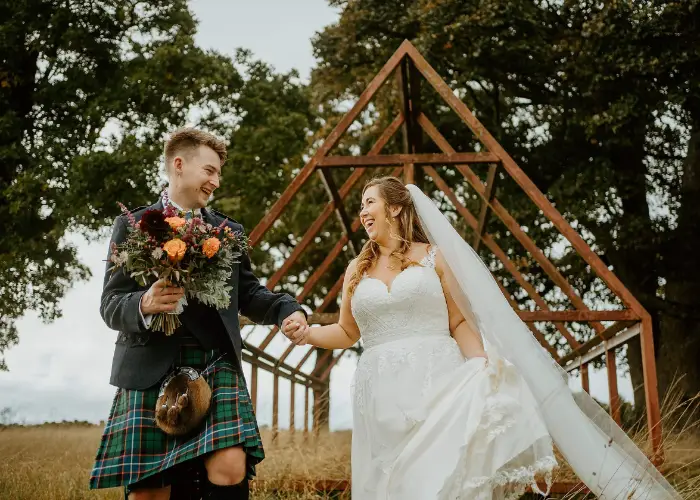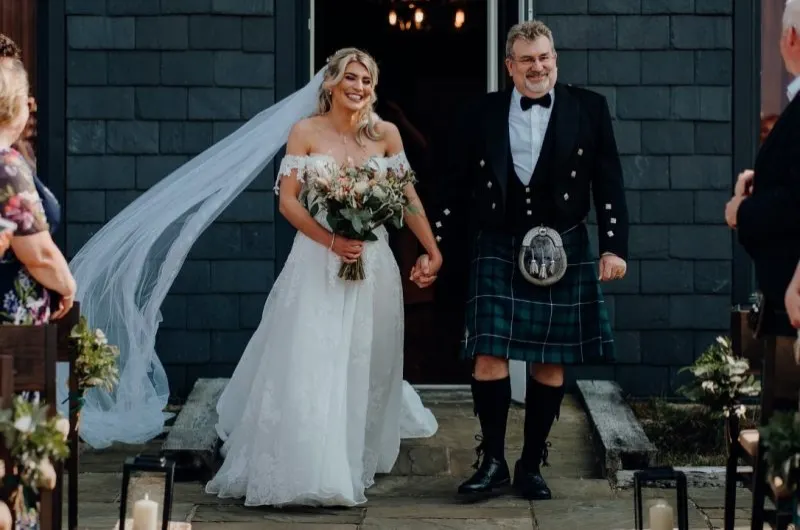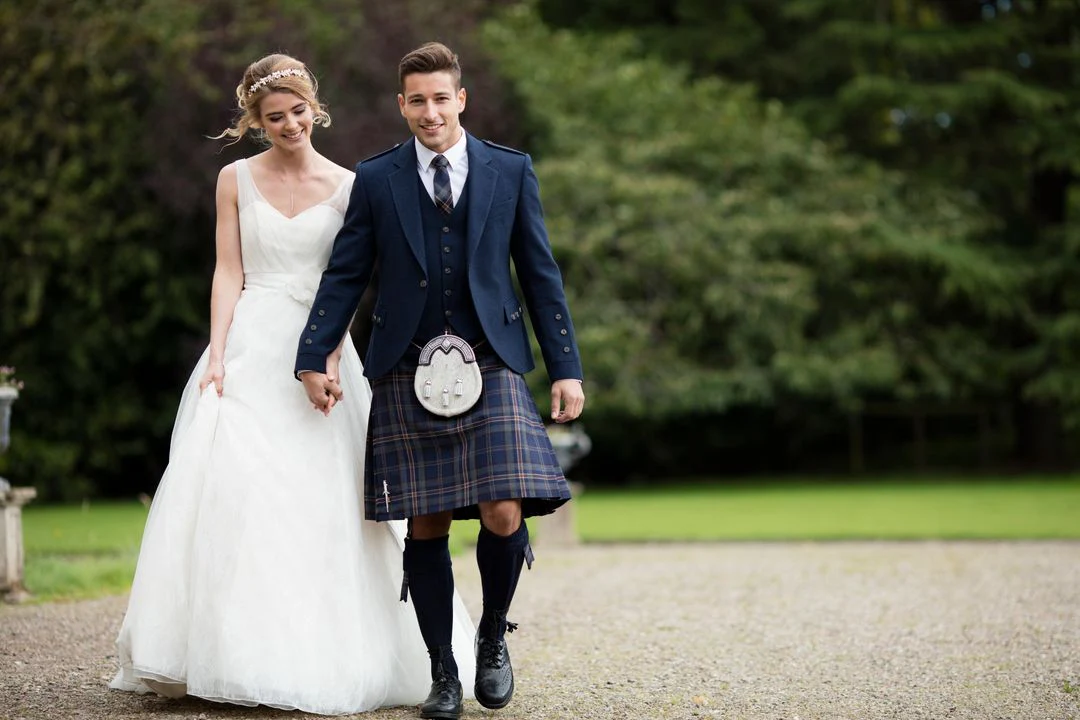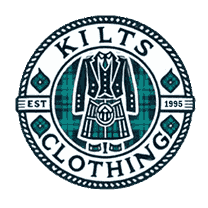Who Wears Kilts at Weddings? A Detailed Guide to Modern Wedding Kilts for Men and Women

Introduction
Mens Kilt have long been a symbol of Scottish heritage, evoking images of tartan-clad Highlanders and ancient traditions. Today, kilt clothing are experiencing a renaissance, particularly at weddings, where they add a unique touch of tradition and style. This comprehensive guide will explore the tradition of kilts at weddings, who wears them, how to choose the proper kilt and tips for a seamless experience.
The Tradition of Kilts in Weddings
Historical Background
- Origins of the Mens Kilt: A Brief History
- The kilt, a knee-length garment with pleats at the back, originated in Scotland in the 16th century. Initially, it was known as the "great kilt" or "belly boot," essentially a long piece of tartan fabric wrapped around the body. Over time, the kilt evolved into the modern version we see today.
- Traditional Uses of Kilts in Scottish Ceremonies
- Historically, kilts were worn as part of traditional Scottish Highland dress for various ceremonies, including weddings. The kilt's significance extends beyond its appearance; it represents clan heritage, social status, and regional pride.
The Kilt in Modern Weddings
- Evolution from Traditional to Contemporary Styles
- In contemporary settings, kilts have adapted to modern fashion trends while maintaining their traditional charm. Today's men's cloth kilt come in various styles and fabrics, making them suitable for formal and casual weddings.
- How Modern Weddings Embrace Kilts
- Kilts are now popular among grooms, groomsmen, and wedding guests. Their unique appearance can add a distinctive flair to a wedding and reflect personal and cultural preferences.
Who Wears Kilts at Weddings?
The Groom
- Traditional Choices for the Groom
- Classic Tartan Patterns:
- For many grooms, choosing a classic tartan pattern honours their Scottish heritage. Popular tartans include the Royal Stewart, Black Watch, and Clan-specific patterns.
- Formal Kilt Styles (e.g., Prince Charlie, Argyll):
- The Prince Charlie kilt suit is the most formal option, featuring a fitted jacket, waistcoat, and bow tie. The Argyll kilt suit is slightly less formal, often worn with a dress shirt and a necktie.
- Personalizing the Groom's Kilt
- Adding Unique Touches: Custom Tartan, Embroidery:
- Grooms can personalize their kilts with custom tartans or embroidered initials, making the kilt even more special and tailored to the individual.
- Complementing the Groom's Attire with Accessories:
- Accessories like a kilt pin, sporran, and kilt hose can complete the groom's look, adding functionality and style.
Groomsmen
- Coordinating Groomsmen's Kilts with the Groom
- Matching Styles and Tartan Patterns:
- Groomsmen typically wear kilts that complement the groom's attire, ensuring a cohesive look for the wedding party.
- Ensuring Uniformity and Coordination:
- Renting kilts can be a practical option for groomsmen to ensure uniformity and manage costs. Coordination with the groom's outfit is essential to maintain a harmonious appearance.
- Practical Considerations
- Rental vs. Purchase Options:
- While purchasing kilts can be a good investment, renting is often more cost-effective for groomsmen.
- Tips for Managing Sizes and Fits:
- Ensure accurate measurements to avoid fitting issues. Most rental services offer size guides to assist with selecting the proper kilt.
Guests
- When Guests Wear Kilts
- Appropriate Occasions for Guests to Wear Kilts:
- Guests can wear kilts to weddings, especially if they are close friends or family with a Scottish background, respecting the wedding theme and the couple's heritage.
- Cultural and Social Considerations:
- Guests should be aware of the dress code and the couple's preferences. Respecting the wedding's formality level and the couple's cultural context is essential.
Guest Etiquette
- How to Respect Traditions and Dress Codes:
- Guests should follow the couple's guidelines regarding kilt attire, ensuring they fit seamlessly into the wedding's theme.
- Choosing the Right Kilt for the Occasion:
- An appropriate kilt style and tartan can enhance the guest's appearance and complement the wedding setting.
Brides and Bridesmaids
- Non-Traditional Brides
- Stylish and Unique Ways to Incorporate Kilts:
- Non-traditional brides may opt for a kilt as part of their wedding dress or as a separate accessory. A tailored kilt skirt provides a unique and stylish alternative to traditional bridal wear.
- Choosing a Kilt Style that Complements the Wedding Dress:
- Brides can choose kilts that align with their wedding dress theme, matching tartan patterns or complementary colours.
Bridesmaids in Kilts
- Coordinating Kilts with the Bridal Party's Attire:
- Bridesmaids' kilts should coordinate with the overall wedding theme. Matching tartan patterns or colours can create a cohesive look for the bridal party.
- Matching with the Wedding Theme and Color Scheme:
- Ensure that the kilts selected for bridesmaids align with the wedding's colour scheme and theme for a harmonious appearance.

Choosing the Right Kilt for a Wedding
Understanding Kilt Fabrics and Patterns
- Fabric Options
- Wool, Acrylic, and Hybrid Fabrics:
- Wool is the traditional fabric for kilts, offering durability and authenticity. Acrylic and hybrid fabrics are more affordable and versatile, suitable for various weather conditions.
- Seasonal Considerations (e.g., Summer vs. Winter):
- Lighter fabrics like cotton or synthetic blends are ideal for summer weddings. In contrast, wool is more appropriate for colder weather, providing warmth and comfort.
- Tartan Patterns
- Traditional vs. Modern Tartans:
- Traditional tartans often represent specific clans or regions, while modern tartans offer a broader range of patterns and colours. Custom tartans can also be created to match personal preferences.
- Custom and Clan Tartans:
- Custom tartans allow for personalization, while clan tartans honour specific family heritage. Choosing the proper tartan can enhance the kilt's significance and connection to Scottish history.
Accessorizing the Kilt
- Essential Accessories
- Sporrans: Types and Styles:
- A sporran is a traditional pouch worn at the front of the Wedding Kilt. It comes in various styles, including fur, leather, and decorative options, adding functionality and flair.
- Belts, Hose, and Gaiters:
- A kilt belt with a decorative buckle, kilt hose (socks), and gaiters complete the look. These accessories ensure the kilt remains in place and add an extra layer of style.
- Complementary Attire
- Jackets and Waistcoats:
- Jackets and waistcoats enhance the kilt's formal appearance. Depending on the wedding's formality, options like the Prince Charlie or Argyll jacket can be chosen.
- Shoes and Socks:
- Traditional kilt shoes, such as ghillie brogues and matching socks, complete the outfit. Ensure that the shoes and socks align with the overall kilt style.
Custom vs. Off-the-Shelf Kilts
- Benefits of Custom Kilts
- Personalization and Fit:
- Custom kilts offer the advantage of personalized measurements and design, ensuring a perfect fit and allowing for unique details, such as custom tartans or embroidery.
- Choosing Materials and Details:
- Custom kilts allow the selection of preferred materials and design elements, tailoring the kilt to individual preferences and needs.
- Pros and Cons of Off-the-Shelf Options
- Cost and Convenience:
- Off-the-shelf kilts are more affordable and readily available. They come in standard sizes and styles, making them a convenient choice for quick solutions.
- Available Styles and Sizes:
- While off-the-shelf options offer a different level of personalization, they provide a range of styles and sizes suitable for various occasions.

Tips for a Seamless Kilt Experience
Getting the Perfect Fit
- Measuring and Sizing Guide:
- Accurate measurements are crucial for a well-fitting kilt. Follow a detailed sizing guide to ensure the kilt fits comfortably and looks stylish.
- Common Fit Issues and How to Resolve Them:
- Address common fit issues, such as length and waist adjustments, by consulting a professional tailor or kilt specialist.
Cultural Sensitivity and Etiquette
- Understanding Scottish Traditions:
- Understanding the kilt's history and traditions can help you respect its cultural significance. This awareness enhances the authenticity and respectfulness of wearing a kilt.
- Avoiding Common Mistakes and Faux Pas:
- Avoid common mistakes, such as incorrect kilt length or inappropriate accessories. Adhering to traditional practices ensures a respectful and polished appearance.
Conclusion
Recap of the Benefits and Versatility of Kilts at Weddings
Kilts offer a unique blend of tradition and modern style, making them a versatile wedding choice. Their rich history and customizable options allow for personal expression and cultural homage.
Encouragement to Explore Kilts at KiltsClothing
Explore the diverse range of kilts and accessories available at KiltsClothing. Whether opting for a custom design or a classic style, there's a kilt to suit every taste and occasion.
Summary of Key Points and Takeaways
Choosing a kilt for a wedding can add a distinctive touch, honouring Scottish heritage while embracing modern trends. Consider the options available, and don't hesitate to seek professional advice to find the perfect kilt.
By incorporating Mens kilt into your wedding attire, you not only celebrate your personal style but also pay homage to a rich tradition that has endured.
FAQs
A tartan sash is typically draped over the shoulder and secured with a brooch. It can be worn over one shoulder or across the body, depending on the occasion and personal preference.
In the rich tapestry of Scottish tradition, women traditionally wear a tartan sash over the left shoulder. This positioning is not just a matter of style, but a sign of respect for the deep-rooted cultural norms of Scotland.
To ensure your comfort, drape the sash over your dominant shoulder and fasten it with a brooch at the shoulder or hip. The key is to make sure it hangs evenly and comfortably, allowing you to move with ease.
A mini tartan sash can be worn similarly to a regular sash but is often styled around the waist like a belt or over the shoulder for a more contemporary look.
A sash is typically draped over one shoulder and fastened with a brooch or pin at the hip or shoulder. It should hang neatly and not restrict movement.
A Cornish tartan sash is worn over the left shoulder and secured with a brooch. It follows the same traditional styling as other tartan sashes but features the unique Cornish tartan pattern.
A Scottish tartan sash is worn over the left shoulder and fastened with a brooch. It can be styled in various ways, such as across the body or over the shoulder, to reflect personal preference and occasion.

